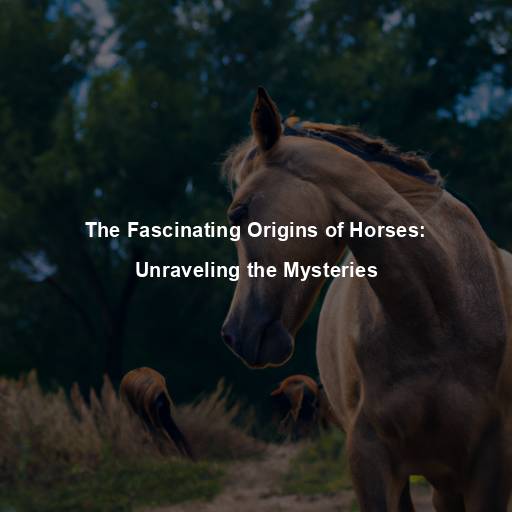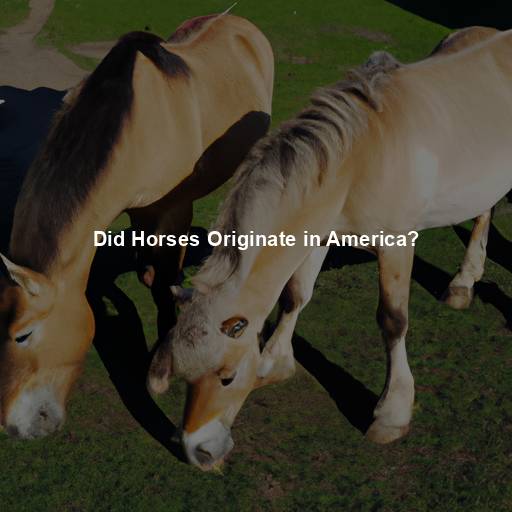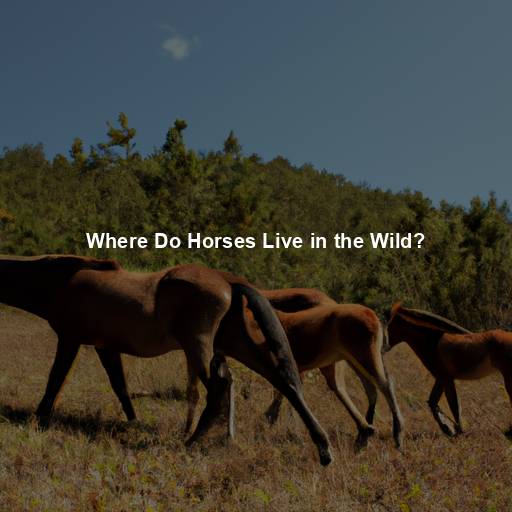The Fascinating Origins of Horses: Unraveling the Mysteries
Last Updated on October 22, 2023 by Evan
Contents [hide]
- 1 A Journey Through Time: Tracing the Origins of Horses
- 2 The Impact of Human Interaction: Domestication and Beyond
- 3 Unraveling the DNA: Genetic Insights into Horse Origins
- 4 The Everlasting Legacy: Horses in the Modern World
- 5 A Tapestry of History Unraveled: The Mystery of Horse Origins
- 6 The Nature of Equus: Understanding Horse Behavior
- 7 The Future of Equine Conservation: Challenges and Initiatives
- 8 FAQs – Where did horses come from?
A Journey Through Time: Tracing the Origins of Horses
The Ancient Ancestors: The Dawn of Equidae
The story of horses begins millions of years ago, in the depths of history. The roots of these magnificent creatures can be traced back to the dawn of the Equidae family, which emerged during the Eocene epoch – approximately 56 to 34 million years ago. These early ancestors, known as eohippus or “dawn horse,” were small in size, about the size of a dog, and roamed the lush forests of North America.
Evolutionary Transformations: From Forest to Grassland Dwellers
As the wheels of time turned, the humble eohippus embarked on a perplexing journey of evolution, entranced by the dance of its ever-shifting surroundings. In the grand theater of life, the transition from lush forests to boundless grasslands became a vital catalyst for the metamorphosis of our equine companions. With each stride and grazing moment, nature’s hand carefully carved longer limbs for graceful symphonies of running, forged specialized teeth for the delicate art of grass indulgence, and sculpted a digestive system capable of harmoniously processing the new cuisine of greens.
The Ancient Wonders: Przewalski’s Horse and the Tarpan
Among the diverse lineage of horses, two ancient breeds stand out as crucial pieces of the puzzle – Przewalski’s horse and the tarpan. Przewalski’s horse, also known as the Mongolian wild horse, is considered the only surviving species of wild horse today. With its distinct appearance and genetic uniqueness, this breed provides valuable insights into the ancestral traits of horses.
Similarly, the tarpan, an extinct wild horse species, left an indelible mark on equine history. Once widely spread across Europe, these majestic creatures roamed freely for centuries before succumbing to the pressures of human activities and habitat loss. The tarpan’s existence, although now confined to historical records and preserved DNA, adds another layer of complexity to the fascinating tapestry of horse origins.
The Impact of Human Interaction: Domestication and Beyond
A Profound Bond: The Dawn of Horse Domestication
The taming and domestication of horses represent one of the most significant milestones in human history. Around 4000 BCE, humans began to harness the power and companionship of these remarkable animals. It is believed that the first domesticated horses originated in the Eurasian Steppe, a vast grassland stretching from Ukraine to Mongolia.
The Chariot Era: Horses as Vehicles of Civilization
Throughout history, a remarkable evolution unfolded as our kinship with horses reached a sublime crescendo during the era of chariotry. As these majestic creatures became intertwined with the fabric of civilizations, their innate power metamorphosed trade routes, communication networks, and even the tides of military conquest. The enigmatic charm and sheer velocity of horses reshaped warfare’s very essence, leaving an indelible mark on the annals of time. From the enigmatic mares of ancient Egypt’s glorious chariots to the awe-inspiring horse-mounted armies of Genghis Khan, the mystical bond between equine and human burgeoned, emboldening our shared legacy across generations.
Cultural Significance: Horses in Mythology and Symbolism
Beyond their practical uses, horses have held immense cultural significance throughout human civilization. From Greek mythology’s majestic winged horse Pegasus to the Norse legends of Sleipnir, the eight-legged horse ridden by Odin, these creatures have captured the human imagination and found their place in folklore, literature, and art.
Throughout diverse cultures across the globe, horses have remained potent symbols of strength, liberation, resilience, and elegance. They encapsulate the very essence of exploration, embodying the untamed allure of the natural world that resonates deep within our souls. In the present day, horse races, equestrian competitions, and majestic equine exhibitions continue to mesmerize onlookers, paying homage to the profound heritage and enduring splendor of these awe-inspiring creatures.
Unraveling the DNA: Genetic Insights into Horse Origins
Genetic Studies and the Horse Family Tree
Over the past few years, the fascinating realm of genetic research has bestowed us with unprecedented insights into the enigmatic origins of horses. This captivating discipline has allowed scientists to delve deep into the intricacies of the equine world, unearthing a trove of information that illuminates the ancestral ties between diverse horse breeds and their ancient kin. By unraveling the intricate strands of DNA, researchers have unlocked a labyrinth of knowledge, painting a vivid picture of the captivating tapestry that connects these magnificent creatures across generations.
The Primal Maternal Line: Mitochondrial DNA
The world of equine genetics has been forever changed by an astonishing revelation: the enigmatic secrets of mitochondrial DNA. This cryptic companion, solely inherited from the maternal line, has unveiled a striking tale of ancestral connections in the realm of horses. Through meticulous scrutiny, researchers have uncovered a startling revelation: a resplendent matriarch known as the “Eve of horses,” a mare from the depths of antiquity who unifies the lineage of all present-day equines. This bewildering discovery, dating back some 130,000 years, thrusts us into a realm of bewildering interconnectedness, where the threads of equine existence converge upon a single enigmatic figure.
The Hybrid Origins: Intertwined Bloodlines
While horses exhibit remarkable diversity in their appearance and traits, their genetic makeup reveals a complex web of interbreeding and hybridization. Over centuries, various horse breeds have mingled and interbred, resulting in a fascinating mosaic of genetic contributions from different ancestral lines. This intricate process of genetic exchange has contributed to the rich tapestry of horse breeds we see today.
The Everlasting Legacy: Horses in the Modern World
Equestrian Sports and Recreation
In the modern era, horses continue to enchant and inspire us. Equestrian sports, such as horse racing, show jumping, dressage, and polo, showcase the remarkable athletic abilities and the deep bond between humans and horses. These sports bring together riders and their equine partners in thrilling displays of grace, precision, and teamwork.
Therapy and Healing: Equine-Assisted Activities
Beyond the realms of sports and recreation, horses have also found a special place in therapeutic settings. Equine-assisted activities, such as therapeutic riding and hippotherapy, harness the unique connection between humans and horses to promote physical, emotional, and cognitive well-being. The gentle presence of horses has the power to heal and uplift, providing solace to individuals facing physical disabilities, mental health challenges, and emotional traumas.
Conservation Efforts: Protecting Wild Horses and Their Habitat
In this rapidly evolving world, it falls upon us to be the champions for our planet and the creatures that inhabit it. Among these majestic beings, wild horses deserve our utmost care and protection. Committed organizations and progressive initiatives are unyieldingly dedicated to preserving the untamed beauty of these creatures, with the aim of securing their existence for generations to come. By amplifying our voice, implementing sustainable practices, and rallying for legislation in their favor, we have the power to pave a path towards a more promising tomorrow for these captivating creatures.
A Tapestry of History Unraveled: The Mystery of Horse Origins
Embark on a captivating journey through time as we unravel the captivating narrative of horses, enveloped in a rich tapestry of history and evolution. From their humble beginnings as ancient ancestors to their profound connection with humans, these majestic creatures have etched an everlasting impression on the fabric of our world. Explore the intricate web of genetics that weaves together the diverse breeds of horses, leaving us spellbound by the complexity of their existence. Let us ignite your curiosity and plunge you into the enigmatic realm of equine wonder.
While we may never fully unravel the mysteries surrounding horse origins, our quest for knowledge and understanding continues. With each discovery, we inch closer to comprehending the intricate complexities of these incredible animals and the profound impact they have had on our lives. So, let us embark on this journey together, celebrating the enchanting tale of horses and the remarkable bond they share with humanity. ## The Enigmatic Influence: Horses in Art and Culture
An Endless Muse: Horses in Artistic Expressions
For centuries, the majestic presence of horses has stirred the souls of artists, weaving an intricate tapestry of inspiration that transcends time and medium. From the enigmatic cave paintings of our ancestors, hinting at the wild freedom these creatures represent, to the intricate sculptures that mold their elegance and strength, the artistic world has continuously celebrated their noble existence. Today, in a world filled with vibrant canvases, poised brushes, and pixels that dance, artists continue to harness the elusive essence of horses, fueling our fascination and leaving us in awe of their timeless allure.
Symbolism and Spirituality: Horses in Mythology and Religion
Throughout history, horses have captivated human imagination in ways that seem to defy explanation. From the mythical realms of Greek gods and goddesses to the sacred symbolism of Hinduism, these majestic creatures have woven themselves into the fabric of our collective consciousness. Their presence is not just physical, but also profoundly spiritual – a bridge that spans the gap between earthly existence and divine realms. The worldwide allure and reverence for horses is a testament to their enigmatic power and the profound impact they have had on human culture.
Equine-Assisted Therapy: Healing with Horses
In recent years, the therapeutic benefits of interactions with horses have gained recognition and popularity. Equine-assisted therapy programs have emerged as a powerful tool for promoting physical and emotional healing in individuals with various conditions, including autism, post-traumatic stress disorder (PTSD), and substance abuse. The gentle presence of horses, their non-judgmental nature, and their ability to mirror human emotions create a unique and effective therapeutic environment, fostering personal growth, self-awareness, and improved well-being.
The Nature of Equus: Understanding Horse Behavior
Social Structures: Herds and Hierarchy
Horses, these captivating creatures, are a testament to the complexity of nature’s social fabric. With their well-defined herd structures and ingrained sense of social order, they exhibit a level of organization that bewilders the human mind. Within these herds, a mare takes on the role of a steadfast leader, navigating the ebb and flow of relationships to promote unity and security. To truly comprehend and connect with these majestic beings, it is imperative for us to grasp the intricate dance of dominance and submission, uncovering the hidden roles and responsibilities that each horse possesses.
Communication and Body Language
The incredible world of equine communication unveils itself through a captivating symphony of intricate body language and mesmerizing vocalizations. Horses, masters of expression, enchant us with their subtle yet profound methods of conveying emotions, intentions, and even warnings. From the eloquent flick of an ear to the graceful sway of a tail, these majestic creatures beckon us to decipher their cryptic yet captivating lexicon. By immersing ourselves in their mesmerizing communication dance, we are granted the privilege of forging profound bonds and unraveling the secret language of these extraordinary creatures.
Instincts and Natural Behaviors
Horses possess a range of instinctual behaviors that have been shaped by their evolutionary history. These behaviors include grazing, herd cohesion, flight response, and grooming rituals. Recognizing and respecting these natural behaviors is vital for providing horses with a suitable environment and ensuring their physical and mental well-being. By allowing horses to express their innate instincts, we can create a harmonious and enriching life for them.
The Future of Equine Conservation: Challenges and Initiatives
Preserving Wild Horses and Their Habitats
The preservation of wild horses and their natural habitats is an ongoing challenge in the face of increasing human encroachment and environmental changes. Efforts are being made by conservation organizations, government agencies, and passionate individuals to protect these majestic creatures and the ecosystems they inhabit. Through land conservation, habitat restoration, and sustainable management practices, we can contribute to the long-term survival and well-being of wild horses.
Responsible Horse Breeding and Ownership
Responsible horse breeding and ownership play a crucial role in ensuring the welfare and sustainability of these magnificent animals. Breeders and owners must prioritize the health and genetic diversity of horses, avoiding overbreeding and promoting responsible ownership practices. This includes proper training, appropriate healthcare, and providing suitable living conditions that meet the physical, social, and behavioral needs of these remarkable creatures.
Education and Advocacy for Equine Welfare
In our ongoing quest to protect the rights and welfare of our equine friends, it is imperative that we bring about a wave of awareness and support for their cause. Harnessing the power of education initiatives, public outreach campaigns, and effective legislation, we can confront the disturbingly prevalent issues of horse abuse, neglect, and illicit horse trading. By fostering a culture of responsible horse care, cultivating empathy towards these majestic creatures, and advocating for ethical standards across the board, we can pave the way for a future where horses reign supreme in a world that values their worth.
FAQs – Where did horses come from?
What is the evolutionary origin of horses?
The evolutionary origin of horses can be traced back to an ancient ancestor known as Eohippus, also called the “dawn horse.” Eohippus lived approximately 50 million years ago during the Eocene epoch. Over time, through a process of natural selection and adaptation, Eohippus gradually evolved into the modern-day horse we are familiar with.
How did horses evolve through the ages?
Throughout the vast expanse of time, the humble Eohippus embarked on a bewildering journey of transformation. The once diminutive creature embarked on a spiraling voyage of perplexity, evolving into larger beings with legs that stretched towards the heavens. As the grasslands beckoned, these enigmatic creatures steadily developed a refined digestive system, one that could harmonize with the verdant bounty that awaited them. Their teeth, a testament to nature’s bewildering artistry, underwent a metamorphosis, transforming into specialized grinding tools capable of taming their newfound diet. In this tapestry spun over the course of countless eons, the majestic tapestry of horses unfurled, casting a mesmerizing array of breeds that captivate our imagination to this very day.
Where were the first horses domesticated?
The domestication of horses is believed to have originated on the Eurasian continent, specifically in the regions of Central Asia and Eastern Europe. It is thought that the Botai culture in present-day Kazakhstan, around 5,500 years ago, was one of the first to successfully domesticate horses. These early domesticated horses played a crucial role in the development of human societies, revolutionizing transportation, agriculture, and warfare.
What are the wild ancestors of modern horses?
Step into the enthralling realm of equine lineage and behold the enigmatic ancestors of our beloved modern horses. Amongst them, the untamed Przewalski’s horse, known as the elusive takhi, and the enigmatic Tarpan proudly thrive. In a breathtaking tapestry of time, these wild equine beings bear a captivating resemblance to their domestic counterparts yet retain their primal essence. A genetic thread unites the Przewalski’s horse to the very horses that embraced domestication’s yoke eons past, further igniting our curiosity and bewilderment.
How did horses spread across the world?
Throughout history, the presence of horses has woven a fascinating tapestry, laden with intrigue and wonder. These majestic creatures embarked on a remarkable journey, their hoofprints tracing the footsteps of human migration and the intricate web of trade routes. As humans ventured into uncharted territories, they carried with them the noble companionship of horses, seeding new lands with their charismatic presence. This symbiotic relationship ignited a fiery spark, kindling the flames of exploration, trade, and even the triumphs of conquest. Originating from their Eurasian cradle of domestication, horses embarked on an audacious expedition, enthralling cultures in far-flung corners of the globe, from the vast plains of North and South America to the enigmatic reaches of Africa, and beyond.
Are there any extinct horse species?
Throughout the pages of history, a tapestry of equine wonder unfolds, unveiling the enigmatic allure of long-lost horse species. Among them, the iconic “tarpan” galloped across the vast European steppes, becoming a haunting legend before bowing out in the perplexing haze of the late 19th century. Not far behind, the magnificent “Caspian horse” held reign over Iran, capturing hearts with its time-honored lineage and claiming its place as one of the oldest horse breeds. These ethereal creatures, now but whispers in the annals of time, gift us profound glimpses into the mesmerizing evolutionary saga of these graceful beings.







